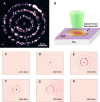Spatially Resolved Quantum Sensing with High-Density Bubble-Printed Nanodiamonds
- PMID: 39052913
- PMCID: PMC11311541
- DOI: 10.1021/acs.nanolett.4c02519
Spatially Resolved Quantum Sensing with High-Density Bubble-Printed Nanodiamonds
Abstract
Nitrogen-vacancy (NV-) centers in nanodiamonds have emerged as a versatile platform for a wide range of applications, including bioimaging, photonics, and quantum sensing. However, the widespread adoption of nanodiamonds in practical applications has been hindered by the challenges associated with patterning them into high-resolution features with sufficient throughput. In this work, we overcome these limitations by introducing a direct laser-writing bubble printing technique that enables the precise fabrication of two-dimensional nanodiamond patterns. The printed nanodiamonds exhibit a high packing density and strong photoluminescence emission, as well as robust optically detected magnetic resonance (ODMR) signals. We further harness the spatially resolved ODMR of the nanodiamond patterns to demonstrate the mapping of two-dimensional temperature gradients using high frame rate widefield lock-in fluorescence imaging. This capability paves the way for integrating nanodiamond-based quantum sensors into practical devices and systems, opening new possibilities for applications involving high-resolution thermal imaging and biosensing.
Keywords: Bubble Printing; Magnetic Resonance Imaging; NV centers; Nanodiamonds; Quantum Sensing; Thermometry.
Conflict of interest statement
The authors declare no competing financial interest.
Figures





References
-
- Nemoto K.; Trupke M.; Devitt S. J.; Stephens A. M.; Scharfenberger B.; Buczak K.; Nöbauer T.; Everitt M. S.; Schmiedmayer J.; Munro W. J. Photonic Architecture for Scalable Quantum Information Processing in Diamond. Phys. Rev. X 2014, 4 (3), 031022.10.1103/PhysRevX.4.031022. - DOI
-
- Barclay P. E.; Fu K.-M. C.; Santori C.; Beausoleil R. G. Chip-Based Microcavities Coupled to Nitrogen-Vacancy Centers in Single Crystal Diamond. Appl. Phys. Lett. 2009, 95 (19), 191115.10.1063/1.3262948. - DOI

